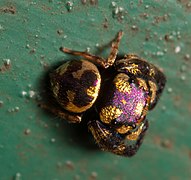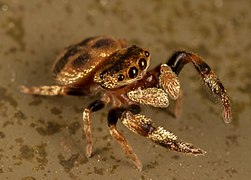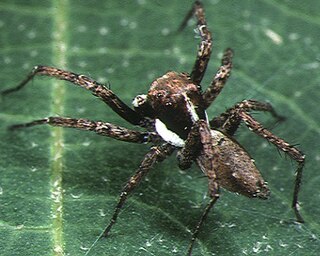
Portia is a genus of jumping spider that feeds on other spiders. They are remarkable for their intelligent hunting behaviour, which suggests that they are capable of learning and problem solving, traits normally attributed to much larger animals.

Epeus is a genus of the spider family Salticidae. They are often found on broad-leaved plants or shrubs of rain forest, or in gardens of Southeast Asia.
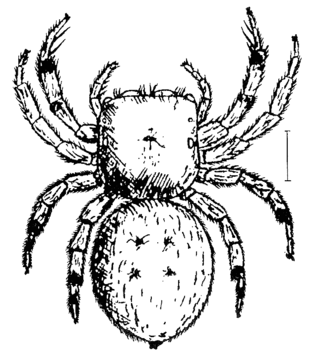
Irura is a genus of the spider family Salticidae.

Pancorius is a genus of Asian jumping spiders that was first described by Eugène Louis Simon in 1902. They are similar to Hyllus.

Salticus is a genus of the family Salticidae. Salticus is the type genus for the family Salticidae.

Simaetha is a genus of Australasian jumping spiders that was first described by Tamerlan Thorell in 1881. They resemble members of Simaethula and Stertinius.

Vailimia is a genus of Asian jumping spiders. The type species was described in 1907 from a single male about 6 millimetres (0.24 in) long. It was originally thought to be close to Harmochirus, but the male pedipalp, chelicera, and cephalothorax drawn by Proszynski in 1984, and information gained from later collected specimens indicates otherwise. Subsequently, five more species have been identified. It may be a synonym for Pancorius.

Zygoballus is a genus of jumping spiders found in North and South America.
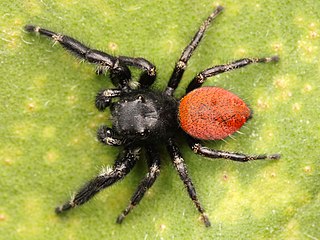
Phidippus johnsoni, the red-backed jumping spider or Johnson jumping spider, is one of the largest and most commonly encountered jumping spiders of western North America. It is not to be confused with the unrelated and highly venomous redback spider.

Cosmophasis umbratica is a species of jumping spider found in South and Southeast Asia. They are members of the family Salticidae and the genus Cosmophasis. They are commonly spotted on green vegetation. C. umbratica shows extreme dimorphism when viewed under UV light: males reflect UV on all body parts that are displayed during intraspecific interaction, while females and juveniles do not reflect UV at all. It seems that C. umbratica uses this in sexual signaling. A similar phenomenon is found in some butterflies. For example, several species of Colias and Gonepteryx, both of the family Pieridae, also display sexual signaling.
Nigorella is a genus of jumping spiders that was first described by Wanda Wesołowska & Beata Tomasiewicz in 2008. The name is described as "an arbitrary combination of letters", feminine in gender. Three previously species described were transferred to the genus: Pachypoessa albimana as N. albimana, Philaeus manicus as N. manica, and Euophrys plebeja as N. plebeja. Subsequently it was discovered that Euophrys plebeja was a nomen dubium, with no known type specimen.

Zygoballus sexpunctatus is a species of jumping spider which occurs in the southeastern United States where it can be found in a variety of grassy habitats. Adult spiders measure between 3 and 4.5 mm in length. The cephalothorax and abdomen are bronze to black in color, with reddish brown or yellowish legs. The male has distinctive enlarged chelicerae and front femora. Like many jumping spiders, Z. sexpunctatus males exhibit ritualized courtship and agonistic behavior.

Anasaitis canosa, previously of the genus Corythalia, is a small jumping spider that can typically be found atop leaf-litter or man-made structures such as fences and exterior walls. This species is more commonly known as the twin-flagged jumping spider due to the two pennant shaped markings on the dorsal side of the cephalothorax. Typical of the genus Anasaitis, this species has iridescent setae ("scales") which may appear white, green or pink which create the "flags" as well as patches on the male pedipalps used in courtship and intraspecific signaling. This species is roughly 5 to 6 mm in length. A. canosa ranges from Mexico to South Carolina along the Gulf of Mexico.
Hermosa is a genus of jumping spiders first described by G. W. Peckham and E. G. Peckham in 1892, and synonymized with Myrmarachne in 1901. In 2016, Jerzy Prószyński split up Myrmarachne, creating nine new genera, all with names beginning "Myrm". However, it turned out that Myrmavola volatilis, the type species of Myrmavola, was also the type species of Hermosa, and Myrmavola was made a junior synonym. It is part of the Myrmarachnini tribe within the Salticoida clade of Salticinae.

Hyllus ramadanii is a species of jumping spider in the genus Hyllus that is endemic to Tanzania. It lives in rocky environments. The spider was first described in 2000 by Wanda Wesołowska and Anthony Russell-Smith. The spider is medium-sized, with a brown carapace between 3.1 and 3.2 mm long and an abdomen 3.2 and 5.0 mm long. The female is larger than the male. It can be differentiated from other species in the genus by its coloration and copulatory organs. The male has a pattern of three white patches on its carapace and a horseshoe shape on its abdomen. The female has three irregular orange streaks on its carapace and a yellow pattern that looks like a tree on its abdomen.
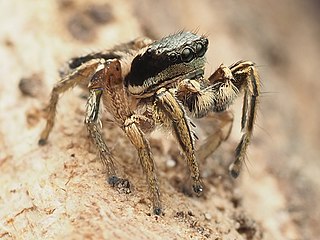
Habronattus mexicanus is a species of jumping spider in the genus Habronattus. The species was first identified in 1896 in Mexico, after which it is named, originally allocated to the genus Habrocestum. The species has subsequently been identified in locations in North and Central America, as well as islands in the Caribbean Sea. The spider is small, but displays one of the most complex sexual displays, including sophisticated vibatory song patterns.

Zygoballus minutus is a species of jumping spider in the genus Zygoballus that was first identified in Guatemala. The spider has also been found in Mexico, and the distribution may extend across Central America. Zygoballus minutus was first described by George and Elizabeth Peckham in 1898. It is a small spider, which is recalled in the name, which is the Latin for small, ranging in length between 3.5 and 4 mm. The male is distinguished by bands of white hair on the abdomen while the female has a pattern of streaks and bands. The palpal bulbs, which are reddish-brown on the male and yellow on the female, are also a distinguishing feature from other species in the genus.

Irura mandarina, also known as the Goldenback jumping spider, is a species of jumping spider found in China, Vietnam and India.

Maevia intermedia is one of eight species of Salticidae, or jumping spider, in the genus Maevia, and is native to North America. This species was originally reported by American Zoologist Robert D. Barnes in 1955 as a needed distinguishment between the similar-looking Maevia species, especially those found in the Americas.


